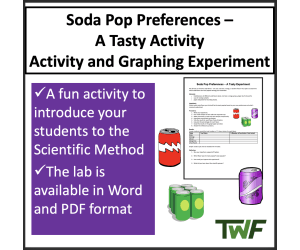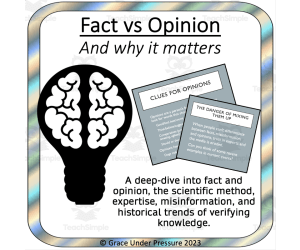2,847 products added recently
Scientific Method Lesson Plan
Guide your students through the process of scientific inquiry with a lesson plan focused on the scientific method. This resource outlines activities that help students understand hypothesis formation, experimentation, observation, and conclusion. Incorporate it to develop essential skills in analysis and logical reasoning.
Scientific Method Unit
Science, Basic Science, Grade 3, 4, 5, Teacher Tools, Lesson Plans
The Scientific Method Unit for 3rd to 5th-Grade Educators This robust teaching resource encapsulates two weeks worth of lesson plans and activities, designed to provide a solid grounding for involving students actively in scientific learning from the start of the academic year. Key Features Fill-in-the-blank notes: Encourages active participation and fosters independent thinking. These complement answer key notes provided specially for teachers to help guide classroom discussion or clarify misconceptions during independent study. Scientific tool rotation centers:: Offers a range of practical applications and explorations opportunities. Four unique experiments:: Centers on concrete applications of the scientific method. It includes observation experiment documentation - along with blank formats to allow flexibility in experiments, it provides insights into different aspects of conducting scientific investigations. Evaluation materials:: Includes both a study guide and quiz as effective tools for revision or student assessment . Comprehensive answer keys are available too, streamlining marking processes while ensuring clarity in feedbacks. Versatility across Educational Setups This unit can serve as either a supplement within broader existing curriculum or stand alone as an inclusive introduction to concepts around the Scientific Method. Easily adaptable within group discussions or small clusters; serves well as homework assignments; or even blends seamlessly into homeschooling routines. Inquiry-based Learning Promotion Focused on delivering immersive science-learning experiences that piques young minds! The goal is transition students into 'scientists' by making abstract concepts tangible through narrative structures combined with interactive activities - saving precious time for teachers without compromising learning quality.</p
Author Kel's Klass
Tags Scientific Method, Hands-on Learning, Inquiry-based Learning, Experiments, Interactive Activities
Soda Pop Preferences - Scientific Method Lesson Included
Science, Basic Science, Grade 6, 7, 8, 9, Lesson Plans, Teacher Tools
Soda Pop Preferences - Scientific Method Lesson Included This engaging activity introduces students to the scientific method through an experiment involving their favorite soda pops. Students will form a hypothesis about which soda flavor they think will be most popular among their classmates. They will then collect data by sorting and counting soda pieces from multiple sample packages. Your students are provided with clear procedures that will guide them to record their results in a well-organized data table and graph. As a class, data can be compiled and percentages calculated to identify trends. Students learn important data analysis skills as they create graphs to visually represent the results. Educators will appreciate the post- experiment reflection questions that reinforce the purpose and process of the scientific method. This hands-on lab nurtures students' natural curiosity while teaching fundamental experimental design. With its real-world topic and tactile investigation, it motivates learners across various grades and learning styles. After completing the activity, students will better understand how to use observation, critical thinking, and representation of evidence to answer a testable question. Additionally, this resource includes my lesson on the Scientific Method. The lesson includes a detailed overview of what the scientific method is as well as how to implement it.
Author Teach With Fergy
Tags Scientific Method, Graphing, Start Of Year
Fact vs. Opinion, Expertise, Scientific Method: A Deep-Dive into Critical Thinking
Social Studies, Special Resources, History, Psychology, Life Skills, Science, Basic Science, Grade 9, 10, 11, 12, Teacher Tools, Lesson Plans
Fact vs. Opinion, Expertise, Scientific Method: A Deep-Dive into Critical Thinking This editable Powerpoint presentation with 14 slides allows teachers to select how deep a dive to embark on with their class when teaching students about facts and opinions. It includes information on several important critical thinking and media literacy topics that will help students start to become thoughtful learners and members of society: How do you differentiate between facts and opinions? (Includes practice questions and answer key.) How do ideas or hypotheses become facts through the use of the scientific method? Why do we sometimes need to trust experts in different fields and how can we evaluate different sources of information? Links to current events and trends and why presenting misinformation as your opinion can be dangerous. Historical trends in the knowledge sources we have accepted as a society and where we might go from here. How to Use: You can decide how much or how little of this presentation to show your class. You may want to start with the fact and opinions slides early in the year and refer to some of the more complex ideas in another term. You can edit the slides as you see fit for your specific class. After presenting all of the slides, you can have your students write a reflection using the prompts included on the last slide. Grades to Use With: This lesson is designed for high school students in grades 9-12 to help enhance their critical thinking and media literacy skills. It could be used in ELA, Science, or Social Studies classes. What's Included: A total of 14 pages: Title Page Definitions Facts Opinions Practice Questions Grey Areas Measurement Experts Differing Standards for Different Experts Why Does it Matter? Misinformation Brief History of Knowledge Sources Reflection Please note: the information in this presentation is based on an understanding of the scientific method and well-proven facts such as the existence of climate change and the efficacy of vaccines.
Author Grace Under Pressure
Tags Critical Thinking, Fact Vs Opinion, Expertise, Scientific Method, Fact And Opinion, Media Literacy, Science Lesson, Social Studies Lesson, Middle School, Life Skills
Scientific Method – M&M’s Activity – Graphing Experiment and Lesson
Science, Basic Science, Grade 6, 7, 8, 9, Lesson Plans, Teacher Tools
Scientific Method – M&M’s Activity – Graphing Experiment and Lesson This colorful activity introduces students to both the scientific method and data analysis through hands-on exploration of M&M distributions. Using a familiar snack, students will form a hypothesis about which candy colors occur most frequently. Clear procedures guide your students to sort, count, and record M&M colors from multiple sample packs. Their results tables lead to graphing skills as data is compiled and percentages calculated. Students learn by doing as they test hypotheses, control variables, and analyze trends. Post-lab reflection questions help internalize the purpose and cognitive skills nurtured. The thorough companion lesson defines each component of the method. Examples illustrate how curiosity and evidence-based thinking benefit discovery. This multi-sensory lab motivates learners across disciplines through discovery fueled by their own observations. After participating, students emerge with a strengthened understanding of systematic investigation and interpretation of quantitative results. Additionally, this resource includes my complete lesson on the scientific method. The lesson will teach your students what the scientific method is as well as how it can be carried out to solve problems and get answers to questions. You, as their teacher, will appreciate how the included lesson reinforces each stage of the scientific process, from questioning to discussing conclusions.
Author Teach With Fergy
Tags Scientific Method, Graphing, Start Of Year, M&m Lab, M And M Graphing Worksheets, Scientific Method Classroom Activities, M&m Fractions Activity, M&m Math Worksheet, M&m Scientific Method Experiment, M&m Science Projects, M And M Science Experiment, Middle School Scientific Method Lab, M&m Science Fair Project, Scientific Method Labs Middle School, M And M Graphing Worksheet, M&m Science Project, M&m Graphs, M&m Science Experiment, M&m Science Fair Projects, M&m Fraction Activities





